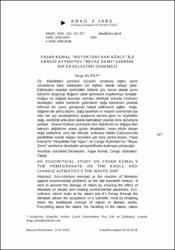| dc.contributor.author | Alpay, İmge | |
| dc.date.accessioned | 2018-10-15T13:04:59Z | |
| dc.date.available | 2018-10-15T13:04:59Z | |
| dc.date.issued | 2018 | |
| dc.identifier.uri | https://hdl.handle.net/20.500.11776/3036 | |
| dc.description.abstract | Ekoeleştiri yirminci yüzyılın sonlanna doğru çevre sorunlarına karşı edebiyatın bir tepkisi olarak ortaya çıkar. Edebiyatın insanlar üzerindeki etkisini göz önüne alarak çevre bilincini oluşturup doğanın zarar görmesini engellemeyi amaçlar. Doğayı ve doğada bulunan canlılan edebiyat yoluyla inceleyen ekoeleştiri, edebi eserlerde geleneksel doğa kavramını yıkarak bilimsel bir çevre görüşünün kabul edilmesini sağlar. Doğa, doğanın ele alınış biçimi, doğa tasvirleri ve insanın çevresinde var olan her şey ekoeleştirinin araştırma alanına girer ve böylelikle doğa, eserlerde arka plan olarak kalmaktan çıkarak özne durumuna yerleşir. İnsanın fiziksel çevresiyle olan ilişkilerini ve doğaya olan bakışını değiştirme amacı güden ekoeleştiri, insan eliyle oluşan doğa katliamını yeni bir bilinçle önlemeyi bekler.Çalışmamızda yarattıkları eserde doğayı nesneden çok özne yerine koyan, Yaşar Kemal’in “Hüyükteki Nar Ağacı” ve Cengiz Aytmatov’un “Beyaz Gemi” eserlerine ekoeleştiri perspektifinden bakmaya çalışacağız. | en_US |
| dc.description.abstract | Eco-criticism emerged as the reaction of literature against environmental problems on the late twentieth century. It aims to prevent the damage of nature by showing the effect of literature on people and creating environmental awareness. Ecocriticism, which looks at the nature and it’s livings through the literature allows the acceptance of a scientific mind by breaking down the traditional concept of nature in literary works. Everything about the nature, the handling of the nature, naturepoıtraits and everything around the human takes place in the field of research of eco-criticisim, so that nature comes out of the background from the works ans settles to a su^ect. Eco-criticisim wants to change the relations o f human beings with their physical surroundings and their view of nature and waits to prevent the “human made” massacre of nahire with a new consciousness. In this study, we have tried to look at the works “Yasar Kemal’s The Pomegranate On The Knoll And Chıngız Aitmatov’s The White Ship, where both creators !? places the nature more as an su^ect instead of an o^ect, in an eco-criticism perspektive. | en_US |
| dc.language.iso | tur | en_US |
| dc.publisher | Namık Kemal Üniversitesi | en_US |
| dc.rights | info:eu-repo/semantics/openAccess | en_US |
| dc.subject | Eco-criticism | en_US |
| dc.subject | Yasar Kemal | en_US |
| dc.subject | Chingiz Aytmatov | en_US |
| dc.subject | Nature | en_US |
| dc.subject | Ekoeleştiri | en_US |
| dc.subject | Yaşar Kemal | en_US |
| dc.subject | Cengiz Aytmatov | en_US |
| dc.subject | Tabiat | en_US |
| dc.title | Yaşar Kemal “Hüyüktekî Nar Ağacı” İle Cengiz Aytmatov “Beyaz Gemi” Üzerine Bir Ekoeleştiri Denemesi | en_US |
| dc.title.alternative | An Ecocrıtıcal Study On Yasar Kemal’s The Pomegranate On The Knoll And Chıngız Aıtmatov’s The Whıte Shıp | en_US |
| dc.type | article | en_US |
| dc.relation.ispartof | Anadolu Ve Balkan Araştırmaları Dergisi | en_US |
| dc.department | Tekirdağ Namık Kemal Üniversitesi Dergileri | en_US |
| dc.authorid | 187720 | en_US |
| dc.identifier.volume | 1 | en_US |
| dc.identifier.issue | 2 | en_US |
| dc.identifier.startpage | 147 | en_US |
| dc.identifier.endpage | 157 | en_US |
| dc.relation.publicationcategory | Makale - Ulusal Hakemli Dergi - Başka Kurum Yazarı | en_US |



















